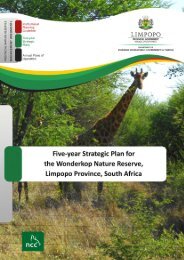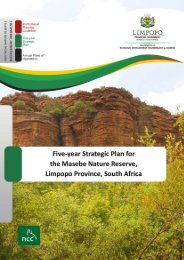Guiding principles for reserve management - NCC Environmental ...
Guiding principles for reserve management - NCC Environmental ...
Guiding principles for reserve management - NCC Environmental ...
- No tags were found...
Create successful ePaper yourself
Turn your PDF publications into a flip-book with our unique Google optimized e-Paper software.
extent and have been extensively used <strong>for</strong> agriculture in the past. Several sinkholes, caves, blind valleysand tufa <strong>for</strong>mations also occur in the south-western dolomitic sections of the <strong>reserve</strong> (Figure 3).Altitudes within the LNR vary from 720 m above sea level at the lowest point in the <strong>reserve</strong> to 1 838 mabove sea level at the point of highest elevation.2.4.4 Geology and Soils2.4.4.1 GeologyA variety of geological <strong>for</strong>mations occur within the LNR, which can generally be grouped according tothe vegetation unit it supports.The geology on which Granite Lowveld occurs (Figure 5) ranges from Archaean granite and gneiss,Swazian Goudplaats Gneiss, Makhutswi Gneiss and Nelspruit Suite to the younger Mpuluzi Granite.Northern Escarpment Quartzite Sourveld geology (Figure 5) comprises Black Reef Group and WolkbergGroup quartzite.Northern Mistbelt Forest (Figure 5) occurs on Pretoria Group shales; Chuniespoort Group deriveddolomite; Black Reef Formation derived quartzite; granite derived from Nelspruit Basement; anddiabase derived from Mokolian intrusives.Poung Dolomite Mountain Bushveld geology (Figure 5) mainly comprises dolomite derived from theMalmani Formation of the Transvaal Supergroup and is always interlayered with chert.The geology of Tzaneen Sour Bushveld (Figure 5) comprises an Archaean granite dyke, as well aspotassium-poor gneisses of the goudplaats gneiss, which underlie most of this vegetation unit. Shalesand quartzite of the Wolkberg Group also occur, but are not common.The geology on which Wolkberg Dolomite Grassland (Figure 5) occurs, is comprised of Malmanidolomites of the Chuniespoort Group.2.4.4.2 SoilsA variety of soil <strong>for</strong>ms occur in the LNR, which can generally be grouped according to the vegetationunit it supports.In the lowlands Granite Lowveld (Figure 5) occurs on clayey soils with a high content of sodium, whilesoils in the uplands are sandy.Northern Escarpment Quartzite Sourveld (Figure 5) occurs on nutrient poor, shallow rocky (quartzite)soils of the Mispah <strong>for</strong>m.Northern Mistbelt Forest (Figure 5) occurs on highly weathered, clayey soils of the Hutton and Avalonsoil <strong>for</strong>ms.Poung Dolomite Mountain Bushveld soils (Figure 5) are alkaline, high in calcium and magnesium andhave low levels of phosphorus. These soils are mostly derived from Mispah soil <strong>for</strong>ms and are shallow,with occasionally deep soils derived from the Hutton and Griffin soil <strong>for</strong>ms.Tzaneen Sour Bushveld soils (Figure 5) vary from shallow to deep, sandy or gravelly well-drained soils ofthe Mispah, Glenrosa or Hutton <strong>for</strong>mations.Reserve Management Documents: Legalameetse Nature Reserve (Strategic Plan) 17

















